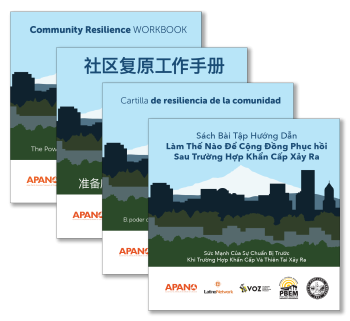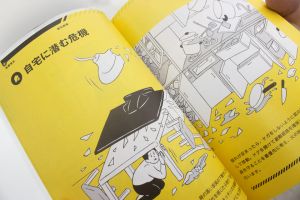Community Education Curricula: Difference between revisions
| Line 66: | Line 66: | ||
'''This resource is not printed by PBEM except by special request. Instead, <u>[https://hcpaw.portlandoregon.gov/u/hQOSiGyDkrmXA5KL/3c2b8fca-e65d-4883-aca0-ec9cfb524d59?l CLICK HERE]</u> to download a ZIP file of the materials.''' Software that can read MS Excel is needed for part of the download. | '''This resource is not printed by PBEM except by special request. Instead, <u>[https://hcpaw.portlandoregon.gov/u/hQOSiGyDkrmXA5KL/3c2b8fca-e65d-4883-aca0-ec9cfb524d59?l CLICK HERE]</u> to download a ZIP file of the materials.''' Software that can read MS Excel is needed for part of the download. | ||
PBEM's Community Resilience Workbook is intended as the best and primary community curriculum resource. However, PBEM has not yet developed a curricula aimed at the particular needs of persons who reside in "vertical communities": apartment or condo buildings. The Vertical Communities E-Prep Packet, designed by John Warner of the Pearl District, is posted here to fill that demand. The Pearl District Neighborhood Association successfully used this curriculum to organize no less than | PBEM's Community Resilience Workbook is intended as the best and primary community curriculum resource. However, PBEM has not yet developed a curricula aimed at the particular needs of persons who reside in "vertical communities": apartment or condo buildings. The Vertical Communities E-Prep Packet, designed by John Warner of the Pearl District, is posted here to fill that demand. The Pearl District Neighborhood Association successfully used this curriculum to organize no less than 35 buildings as of 2020, and other "vertical communities" have adopted and adapted it to their own use as well. | ||
==== Specifications ==== | ==== Specifications ==== | ||
| Line 77: | Line 77: | ||
==== Project history ==== | ==== Project history ==== | ||
In | In 2015, Pearl District NET Team Leader John Warner completed his first iteration of the packet, and it was published to the NET Tumblr in August 2016. | ||
== Other Community Education Curricula == | == Other Community Education Curricula == | ||
Revision as of 15:01, 29 November 2023
| If you wish to request any materials distributed by PBEM, please do so at least two weeks before you need them. You can request materials by completing the online REQUEST FORM. |
This page is intended to serve both the general public and to aid PBEM staff when considering handout updates and ordering materials.
NETwiki distinguishes between printed "Handout Materials" and "Community Education Curricula", and they are posted to different pages:
- Handout Materials are short-form informational resources designed to be used by an individual, typically distributed at community events, and do not necessitate a facilitator or community leader leading neighbors through a learning process.
- Community Education Curricula are long-form informational resources designed for individuals and/or organized neighbors to work through towards a shared resilience goal, and often suggest a neighbor as a "lead facilitator" coordinating the process.
Community Resilience Workbook
| Item | Last Update | ||||
|---|---|---|---|---|---|
| Community Resilience Workbook | 2019.06.12 | en | es | vi | zh |
| Community Resilience Workbook Facilitators' Guide | 2019.06.12 | en | es | vi | zh |
The Community Resilience Workbook is PBEM's principal community resilience curriculum publication. PBEM produced it in partnership with Voz, APANO, and Latino Network in 2018 and 2019. Before PBEM published the Community Resilience Workbook, staff distributed Map Your Neighborhood (MYN). The Community Resilience Workbook was designed to remedy ongoing problems with MYN and have a curriculum:
- Whose design started with equity and inclusion, in order to produce something culturally competent and appealing to many different Portland communities;
- That was relatively easy to print;
- Was available in multiple languages;
- Featured more engaging graphic design than found in most other curricula available.
Specifications
Finishing size is 8 ½" x 8 ½", full color CYMK; color/ink 4/4 with heavy coverage. Printed on REC 90# White-11, recycled content preferred. Booklet is coil bound (PBEM usually uses a clear coil).[1] Composed in InDesign. Graphic design and layout completed by Hexad.
Appropriate Use and Facilitator's Guide
The Community Resilience Workbook was designed to engage a broad social spectrum and generally works well for any gathered group of community members who want to engage in disaster resilience. More specialized curricula might be a better match for some audiences (e.g. tenants in an apartment building might prefer to consider the Vertical Communities Toolkit produced by the Pearl District Neighborhood Association).
Every member of a group participating in going through the Workbook should have their own copy. As it is a Workbook, recipients are encouraged to fill out parts of it begin forming their own resilience plan.
While in the production process, PBEM recognized the need for a Workbook facilitator's guide so that someone could take a group of recipients through a workshop. The Facilitators Guides are also available in multiple languages.
Project history
Prior to starting the Workbook, PBEM relied on Map Your Neighborhood (MYN) as the go-to community resilience curriculum. But MYN had a number of problems: it was (weirdly) copyrighted, it was poorly designed for simple printing (meaning the public had to rely on PBEM to print them copies), several of its concepts were outdated, it was not produced with an equity lens, and it was available only in English. Facilitator guidance did exist as a series of videos, but they were difficult to find because the videos were often taken down from YouTube (possibly because of the copyrighting).
Everyone on PBEM's Community Resilience Team recognized the need to replace MYN as soon as possible. Regina Ingabire led the effort and began development with a series of focus groups in the second half of 2018. Participants in the focus groups included representatives from Voz, APANO, and Latino Network. The focus group produced an initial workbook draft released for review on 11/30/2018. That version of the workbook was roundly rejected by community partners, and the next revision went out on 02/02/2019. About this time, Regina brought graphic design firm Hexad in to begin illustrating workbook concepts and a second draft went out in early March 2019. The final version was completed in Spring 2019, and Hexad began producing versions in multiple languages.
PBEM kicked off initial print runs of the workbook with an extensive campaign envisioned to bring the publication to multiple communities. Unfortunately, the COVID pandemic in early 2020 handily obliterated that plan, and the Workbook never made a strong debut.
Vertical Communities E-Prep Packet
This resource is not printed by PBEM except by special request. Instead, CLICK HERE to download a ZIP file of the materials. Software that can read MS Excel is needed for part of the download.
PBEM's Community Resilience Workbook is intended as the best and primary community curriculum resource. However, PBEM has not yet developed a curricula aimed at the particular needs of persons who reside in "vertical communities": apartment or condo buildings. The Vertical Communities E-Prep Packet, designed by John Warner of the Pearl District, is posted here to fill that demand. The Pearl District Neighborhood Association successfully used this curriculum to organize no less than 35 buildings as of 2020, and other "vertical communities" have adopted and adapted it to their own use as well.
Specifications
The packet pages can print on a regular home printer at 8 ½" x 11" sheets.
Appropriate Use
TBA
Facilitators can supplement the packet materials with information found at the NET Tumblr "Vertical" tag: https://portlandnet.tumblr.com/tagged/vertical.
Project history
In 2015, Pearl District NET Team Leader John Warner completed his first iteration of the packet, and it was published to the NET Tumblr in August 2016.
Other Community Education Curricula
The following curricula is not published, distributed, or specifically recommended by PBEM. Information about these curricula are posted here in case reviewing them is useful to anyone organizing their communities, and readers can see how others have tried to solve the problem of organizing communities around preparedness.
Obviously, this Wiki cannot make space for every piece of community education curricula ever designed. The curated list below includes curricula PBEM has considered adopting and/or at one time distributed, or that Portlanders may have come across at community events.
Red Cross Prepare! Resource Guide
PDF available at: https://www.redcross.org/local/oregon/about-us/our-work.html
Be 2 Weeks Ready
https://www.oregon.gov/oem/hazardsprep/pages/2-weeks-ready.aspx
Disaster Preparedness Tokyo Manual ("Tokyo Bosai")
PDF available in English at: https://www.metro.tokyo.lg.jp/english/guide/bosai/index.html.[2]
Tokyo Bosai is a disaster preparedness manual (modeled after a manga) developed for Tokyo households by the Tokyo Metropolitan Government and available in English. Though the content is comprehensive and high quality, PBEM has declined to publish and distribute it. Printing costs for a manual of this size makes for a very low return on investment (particularly printing information that anyone can find online for free). Though the manual is popular in Japan, there is no credible data suggesting Portlanders consume disaster preparedness information the same way Tokyoites do.
From the website linked above:
The Tokyo Metropolitan Government has compiled a manual called “Disaster Preparedness Tokyo” (Tokyo Bousai) to help households get fully prepared for various potential disasters, including an earthquake directly hitting Tokyo. “Disaster Preparedness Tokyo” is tailored to the various local features of Tokyo, such as its urban structure and the lifestyles of its residents. It contains easy-to-understand information on how to prepare for and respond to a disaster. This information is useful both in the event of an emergency and to help you prepare proactively now.
A Portland-centered version, created by a local artist, is rumored to be published soon.
Connection is Protection
PDF available at: https://fairvieworegon.gov/431/Emergency-Preparedness

